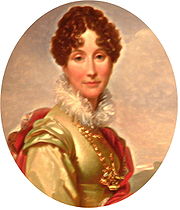
Louise Marie Adelaide Eugènie d'Orléans
Encyclopedia

Paris
Paris is the capital and largest city in France, situated on the river Seine, in northern France, at the heart of the Île-de-France region...
, 23 August 1777 – Paris, 31 December 1847) was one of the twin daughters of Louis Philippe II d'Orléans
Louis Philippe II, Duke of Orléans
Louis Philippe Joseph d'Orléans commonly known as Philippe, was a member of a cadet branch of the House of Bourbon, the ruling dynasty of France. He actively supported the French Revolution and adopted the name Philippe Égalité, but was nonetheless guillotined during the Reign of Terror...
, known as Philippe Égalité during the French Revolution
French Revolution
The French Revolution , sometimes distinguished as the 'Great French Revolution' , was a period of radical social and political upheaval in France and Europe. The absolute monarchy that had ruled France for centuries collapsed in three years...
, and his wife, Louise Marie Adélaïde de Bourbon-Penthièvre. She was titled Mademoiselle de Chartres at birth, Mademoiselle d'Orléans at the death of her twin sister in 1782, Mademoiselle (1783-1812), Madame Adélaïde (1830). As a member of the reigning House of Bourbon
House of Bourbon
The House of Bourbon is a European royal house, a branch of the Capetian dynasty . Bourbon kings first ruled Navarre and France in the 16th century. By the 18th century, members of the Bourbon dynasty also held thrones in Spain, Naples, Sicily, and Parma...
, she was a princesse du sang
Prince du Sang
A prince of the blood was a person who was legitimately descended in the male line from the monarch of a country. In France, the rank of prince du sang was the highest held at court after the immediate family of the king during the ancien régime and the Bourbon Restoration...
.
Biography
During the French Revolution in 1792, she left France with her governess, Madame de Genlis. They fled to BelgiumUnited States of Belgium
The United States of Belgium, part of Brabant.In October, he invaded Brabant and captured Turnhout, defeating the Austrians in the Battle of Turnhout on October 27. Ghent was taken on November 13, and on November 17 the imperial regents Albert of Saxony and Archduchess Maria Christina fled Brussels...
and then to a convent in Switzerland
Switzerland
Switzerland name of one of the Swiss cantons. ; ; ; or ), in its full name the Swiss Confederation , is a federal republic consisting of 26 cantons, with Bern as the seat of the federal authorities. The country is situated in Western Europe,Or Central Europe depending on the definition....
. During the Terror her father was guillotined, and her mother was banished to Spain
Spain
Spain , officially the Kingdom of Spain languages]] under the European Charter for Regional or Minority Languages. In each of these, Spain's official name is as follows:;;;;;;), is a country and member state of the European Union located in southwestern Europe on the Iberian Peninsula...
. Sometime in the spring of 1794 Adélaïde moved to the home of her aunt, the princesse de Conti
Maria Fortunata d'Este
Maria Fortunata d'Este was a Modenese princess by birth and a princess of the blood of France by marriage. By her marriage to a second cousin Louis François Joseph de Bourbon, Prince of Conti, she became the Countess of La Marche and later the Princess of Conti and was a member of the French court...
. They moved to Bavaria in 1798 and thereafter to Bratislava, and in 1801, she joined her mother in Barcelona in Spain.
Upin her return to Paris in France after the fall of Napoleon in 1814, she opened a salon and made Palais-Royal the center of the liberal party and organised the support of her brother. When Louis-Philippe became King of the French in the reign known as the July Monarchy
July Monarchy
The July Monarchy , officially the Kingdom of France , was a period of liberal constitutional monarchy in France under King Louis-Philippe starting with the July Revolution of 1830 and ending with the Revolution of 1848...
(1830-1848), she was known as Madame Adélaïde. All her life, she was his loyal advisor or, in 19th century parlance, his "Egeria
Egeria (mythology)
Egeria was a nymph attributed a legendary role in the early history of Rome as a divine consort and counselor of the Sabine second king of Rome, Numa Pompilius, to whom she imparted laws and rituals pertaining to ancient Roman religion...
". It was she who, reportedly, encouraged him to accept the crown during the July revolution, and her influence continued undisturbed during his reign. She is described as simple and unmaterialistic.
Adélaïde d'Orléans died on 31 December 1847, two months before Louis-Philippe's abdication on 24 February 1848. She is buried in the Orléans family necropolis in the Chapelle Royale de Dreux
Dreux
Dreux is a commune in the Eure-et-Loir department in northern France.-History:Dreux was known in ancient times as Durocassium, the capital of the Durocasses Celtic tribe. Despite the legend, its name was not related with Druids. The Romans established here a fortified camp known as Castrum...
.

